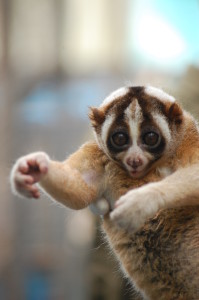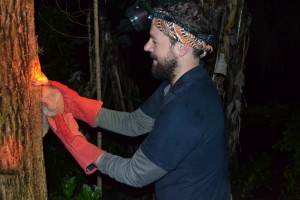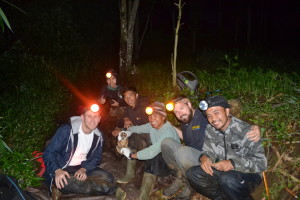My time at Loris Land is almost over. In April I will move from this magical land and go to a rescue centre for two months to finish my studies. It occurred to me that I haven’t even told you all about my research yet! Well, grab a glass (bottle) of wine and get ready for a juicy insight into a loris crazed researcher’s brain. I apologise in advance if I offend anyone with my thoughts.

I have been working in animal nutrition for a while now, and in this modern day and age with all of our “ethics” and lab rules … HOW do we know if we are feeding the right diet to an animal. You feed it … it doesn’t die. Does that mean the diet is good? You feed it, it is alive and breeding and performs natural behaviours? Is that satisfactory? What about giving them the nutrients that they need, but in a presentation that is not at all akin to the wild, such as giving only pellets or a porridge. These are all questions which really interest me and I would like to be able to explore. Nutrition impacts every single facet of an animal’s life because they have adapted to exploit a specific group of foods in the wild.
My personal motto is that captive diets should be based on wild diets. It isn’t always possible to reproduce a wild diet in captivity though so we have to make do with what we have. To study this further, I had the idea of looking exactly at what lorises eat in the wild and then calculating their nutrient intake and translating this into a captive diet. I want to look at every.single.nutrient. Lorises are actually a great model animal for this since their captive diets are currently … so so. Plus, with the sheer amount of lorises in rescue centres, creating a good but cheap diet would be amazing for these poor little guys! A special diet for those without teeth would also be a good addition.

SO one issue with these kind of studies is that you can’t necessarily measure the digestive parameters of your wild animals to use as a “golden standard” when you do diet trials. Armed with a bucket of gum the amazing LFP trackers and I have been collecting over months, dried nectar and insects I will be giving some captive lorises a diet which reflects the proportions and quantities of wild lorises. I’ll then be able to measure how much fibre they can digest, how long it takes the diet to pass through them, see how they behave and see how much food they ingest. I hope to be able to do some fancy microbiology and see the state of their gut microbes as well! Now I make a pretty big assumption that these results will be similar to the wild lorises, which is a whole other thing. With all this info, I will then be able to have diet trials which have the necessary nutrients and measure the SAME things again. The diet which most closely resembles the wild type *should* be the ideal captive diet.

I have lots of ambitions and I really want my studies to help the lorises in any capacity. It would be great if this diet also helps the success of reintroductions but that isn’t for now. I need to finish this study first before I can move on to other things. I can’t believe this adventure is almost over when it feels like I just got my hands into it. I was called Princess on my first day here, and I have remained a princess throughout, yet ever so slightly more rugged now (and beardy).
I look forward to sharing my results with you all!! More from the rescue centre adventures soon 🙂
Francis Cabana
PhD Student and LFP Research Coordinator
